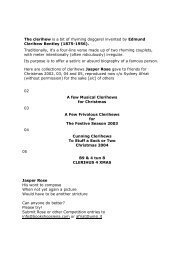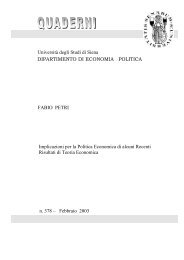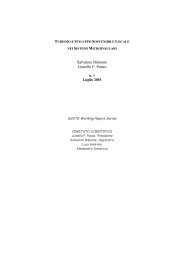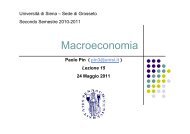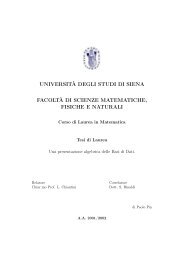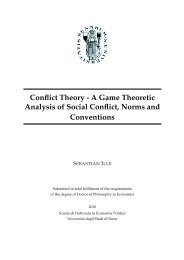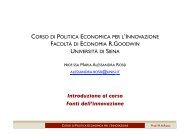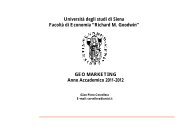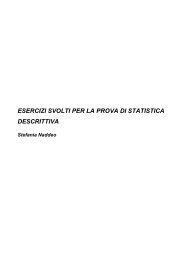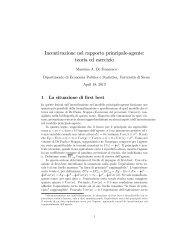Appunti delle lezioni di istituzioni di matematica attuariale per le ...
Appunti delle lezioni di istituzioni di matematica attuariale per le ...
Appunti delle lezioni di istituzioni di matematica attuariale per le ...
You also want an ePaper? Increase the reach of your titles
YUMPU automatically turns print PDFs into web optimized ePapers that Google loves.
dove<br />
d1 =<br />
log S0<br />
K<br />
+ r + 1<br />
2 σ2<br />
σ<br />
= r − log<br />
<br />
1 + i<br />
β<br />
σ<br />
<br />
+ 1<br />
2 σ2<br />
Sostituendo nella (218) l’espressione (219) si ottiene l’asserto.<br />
, d2 = d1 − σ .<br />
Osservazione A.2.3. Poiché il membro destro della (215) non <strong>di</strong>pende da S0, che riassume<br />
<strong>le</strong> con<strong>di</strong>zioni <strong>di</strong> mercato alla data zero <strong>di</strong> valutazione, il risultato ottenuto nel <strong>le</strong>mma A.2.2<br />
non <strong>di</strong>pende separatamente dalla data <strong>di</strong> valutazione zero e dalla scadenza 1, ma solo dalla<br />
durata unitaria. Se si pone <strong>per</strong>tanto<br />
u = 1 −r<br />
(1 − β) e + β N(d1) + (i + β) e<br />
1 + i<br />
−r N(−d2) ,<br />
si può estendere il risultato del <strong>le</strong>mma:<br />
V t − 1, Φ(t − 1, t) = u <strong>per</strong> ogni t > 0. (220)<br />
Osservazione A.2.4. Il fattore unitario <strong>di</strong> valutazione u può essere scritto nella forma equiva<strong>le</strong>nte<br />
Infatti N(−d2) = 1 − N(d2) e quin<strong>di</strong><br />
u = 1 −r<br />
(1 + i) e + β N(d1) − (i + β) e<br />
1 + i<br />
−r N(d2) .<br />
(1 − β) e −r + (i + β) e −r N(−d2) = (1 − β) e −r + (i + β) e −r − (i + β) e −r N(d2)<br />
Teorema A.2.5. Per ogni t > 0 intero si ha<br />
= (1 + i) e −r − (i + β) e −r N(d2) .<br />
V 0, Φ(0, t) = u t , (221)<br />
Dimostrazione. La <strong>di</strong>mostrazione procede <strong>per</strong> induzione su t.<br />
Per t = 1, base dell’induzione, l’asserto è stato <strong>di</strong>mostrato nel <strong>le</strong>mma A.2.2.<br />
Assunto quin<strong>di</strong> vero il risultato <strong>per</strong> t − 1:<br />
V 0, Φ(0, t − 1) = u t−1 ,<br />
osserviamo anzitutto che, <strong>per</strong> l’assenza <strong>di</strong> arbitraggi non rischiosi 25 , risulta<br />
Poiché<br />
Φ(0, t) =<br />
si ottiene quin<strong>di</strong> che<br />
V 0, Φ(0, t) = V 0, V t − 1, Φ(0, t) .<br />
t<br />
<br />
t−1 <br />
(1 + ρk) = (1 + ρk) (1 + ρt) = Φ(0, t − 1) Φ(t − 1, t) ,<br />
k=1<br />
k=1<br />
V 0, Φ(0, t) = V 0, V t − 1, Φ(0, t − 1) Φ(t − 1, t) <br />
25 Se si considera al tempo t un contratto che al tempo s > t paga l’importo Xs, <strong>per</strong> l’ipotesi <strong>di</strong> assenza <strong>di</strong><br />
arbitraggi non rischiosi è sempre vero che <strong>per</strong> ogni data interme<strong>di</strong>a T (t ≤ T ≤ S) il contratto che paga in T<br />
l’importo YT = V (T, Xs) ha prezzo si mercato in t<br />
V (t, YT ) = V t, V (T, Xs) = V (t, Xs) .<br />
c○ C. Pacati 2005, <strong>Appunti</strong> IMAAV, appen<strong>di</strong>ce (v. 26/12/2005) pag. 60



